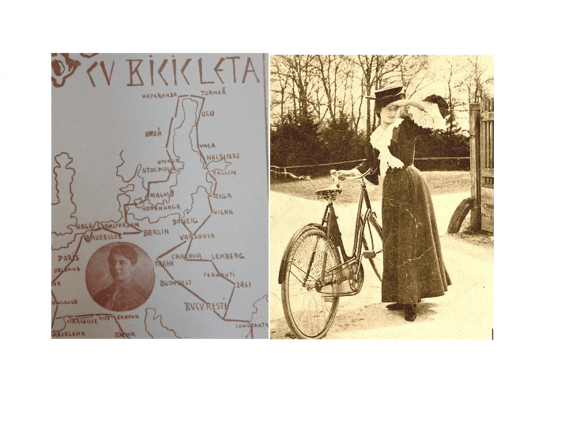
Short Story
Gina Burileanu, O călătorie cu bicicleta [A trip on a bicycle],
Institutul de Arte Grafice ’Muntenia’, București, 1938.
(‘Nicolae Iorga’ Institute of History & New Europe College-Institute for Advanced Study, Bucharest, Romania)
A book about a Romanian woman who travelled across Europe for two years on her bike in the 1930s, this is the synopsis. But let us stop for a moment, not judge it as merely a travel account among others and see what the writing can offer. Going into details might give more insights on the empowering nature of mobility for women, the resources used and the public perceptions on such endeavours.
This book and some newspaper articles are the only thing we have got on her. She presents herself as the daughter of a sailor, born on the ship her father was piloting, with a childhood dominated by the sea and trips on the Danube, between Regensburg and the port of Sulina. Burileanu seems attached to the figure of her father not only because he took her almost wherever he went, but possibly because her mother died when she was 9 years old. With him, she learns to fish, hunt, swim and use a weapon “inheriting bravery and good spirits, and most of all the tenacity in the fight you have to have with nature and people”. The high-school period in the capital of Bucharest, far from home, is seen in less cheerful notes as she considers skills more important than education and the school a place “where I’ve learnt to lie”. Burileanu does not integrate and drops studying taking a number of jobs (tutor, office clerk, cashier etc.) looking for something that might fit to her nature. She learns to use a bike from another girl when she was in the city of Cluj, in the northern part of Romania, and this makes her aspire not only to traverse the country but the entire Europe.
Thus, Gina Burileanu is not a wealthy person nor one well-connected and educated, but has ambition and curiosity. She lies to the official Romanian authorities that she has experience in cycling and, although her aim to travel Europe in this way is publicly announced, almost no one is present at her departure from Bucharest in 1927. This is seen as rather stimulating by her. In the book, she argues that she made ca. 20000 km in her journey with a ratio of 80 km/day while crossing Romania – Poland – Hungary – Cehoslovakia – Latvia – Estonia – Finland – Sweden – Denmark – Germany – Holland – Belgium – France – Spain – Italy – Greece – Turkey. Her account might also be a travel guide as she presents what she liked most in these countries and the people/institutions with whom she entered in contact. However, Gina Burileanu considers some things indispensable and makes a list that opens up the volume as a sort of recommendation for future women who might want to imitate her:
- Tenacity, bravery and good spirits
- Money
- A man’s bike, light, with normal wheels
- A backpack
- Two canisters
- Two cameras
- One bag with all the equipment and tools for repairs
- A map with the highroads
- A revolver at the belt, which you do not have to use it – not to get into trouble with the authorities
- Two rounds of clothes, which you can change with new ones, renouncing at what is old
- A kettle, a bowl for spirt and a cup for tea
- A small pharmacy (tincture of iodine, peroxide, cotton, gauze)
- Morals and manners – think about the fact that you represent a nation.
- Speed – 15-23 km/hour, as this is the only way you can resist to a long journey.
- Passport
- Recommendation from our sport’s authorities
Gina Burileanu comes back to Romania after almost two years, through the port of Constanța, where she is forced to quarantine “because in the Orient was declared a contagious disease”.
The account is published after almost a decade of oblivion, during the royal dictatorship (1938-1940) of Carol II, the presence of fascism, and in the prelude of World War II. Here and there, words of propaganda. One has to lift the “veil” and see the woman’s trajectory and why it is relevant as a story. Personalities argue that the book is about acquiring knowledge, means to strengthen the body and popularize a sport. Still, probably the merit is in transforming an activity (cycling) perceived until then only as a hobby or of bon-ton for women into a normality through which one can surpass boundaries and limits.
Reference:
Gina Burileanu, O călătorie cu bicicleta [A trip on a bicycle], Institutul de Arte Grafice ’Muntenia’, București, 1938.